Seattle Sounders welcomed New York Red Bulls to the CenturyLink Field for a clash between MLS Western and Eastern conference teams. Seattle manager, Brian Schmetzer, managed to lead his team to a 4-2 victory over Chris Armas’ Red Bulls.
The result led Seattle to move up to 2nd in the Western division, while New York Red Bulls remain 6th in the Eastern league regular season. This tactical analysis will investigate how Seattle were able to beat the team from New York. Match analysis, statistics and how each team changed their tactics will feature.
Lineups
To start the match, hosts Seattle utilised a 4-2-3-1 whereas New York Red Bulls operated using a 4-3-1-2 formation. The key differences between these formations is that the Seattle Sounders favoured a balanced approach, with a mix of width and central numbers, requiring average contributions from all players. New York Red Bulls attempted to sacrifice positional width in an attempt to dominate the central midfield positions and up-front. Such a formation places large demands on the left and right central midfield players. These players must contribute in central phases of play as well as moving out to the flanks to support attacks or press an oncoming opponent.
The popular phrase of ‘goals change games’ was in evidence as reactionary tactical formation changes were evident for both teams. Such changes will be discussed as and when they happened during the chronological set of match events which will be detailed after taking a look at the match stats.
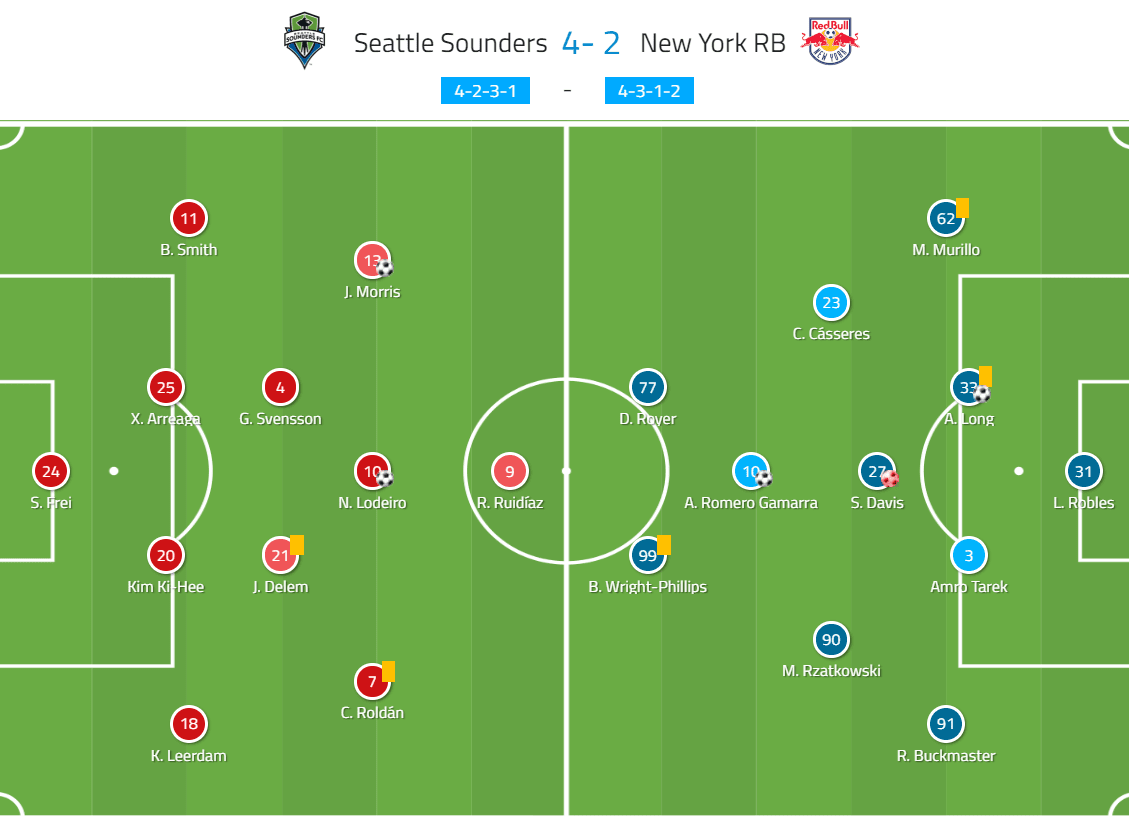
Match stats
While looking at the stats in isolation, we can see that the match statistics suggest that the match was fairly even. Seattle Sounders edged possession 55% to 45%, both teams had the same amount of shots on target and the average shot distance was very similar, although, Seattle did take more shots and more corners. Ultimately, Seattle created more opportunities due to a higher shot number, and higher quality chances, 0.11 average xG per shot, when compared to the New York Red Bulls 0.08 average xG per shot.
Overall, Seattle finished with an xG of 1.7 compared to New York’s 0.89. From this we can also identify that both teams out-performed their xG, such over-performance is usually due to above-average finishing, below average goalkeeping or luck factors. Seattle out-performed their xG, 2.3 xG differential, to a larger extent than New York Red Bulls, 1.11 xG differential, which is also likely to have had an impact on the final score of this match.
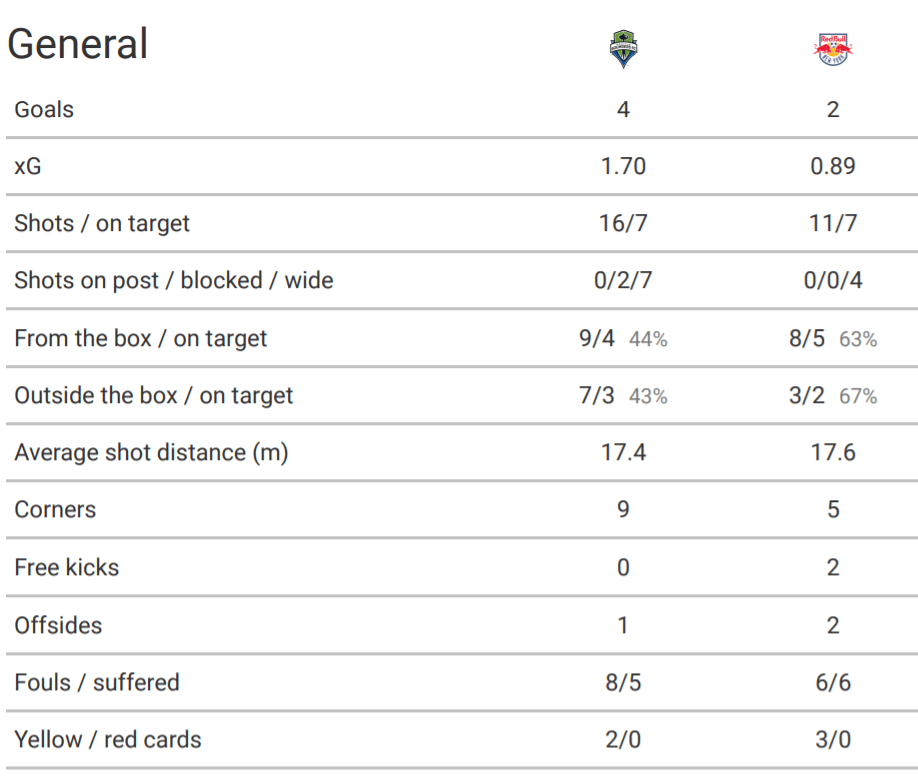
First half
Seattle Sounders took the lead in the second minute. For the first goal, there were no major open play tactical analysis elements to focus on. Seattle utilised early possession in order to progress the ball and win a corner in the second minute. Seattle utilised a left-footer on the right corner of the pitch to curl an in-swinging corner into the box with pace. Seattle won a flick-on at the near post before the ball flicked off Jordan Morris and into the goal from six yards out.
The New York Red Bulls defence of the set-piece was poor. The team set up utilising a zonal marking system, with four players positioned ahead of the near post, supposedly to clear any cross into that area which studies have shown to be one of the most dangerous areas to play a corner into in order to earn a flick-on. Neither man positioned ahead of the near post moved to attack and clear the ball.
As the ball was played in, Seattle attackers ran towards goal and attempted to find gaps between the zonally marking New York Players on the six-yard line. In fairness, such zonally marking defenders may have been aiming to man-mark when the opposition entered their zone. This occurred as defenders followed attacking runs as they arrived. However, multiple defenders weren’t able to match or block the runs of the attackers or attack the ball directly. Because of this, Gustav Svensson was able to run onto the ball and head it goal-bound. Unmarked Jordan Morris was able to finish the set-piece successfully.
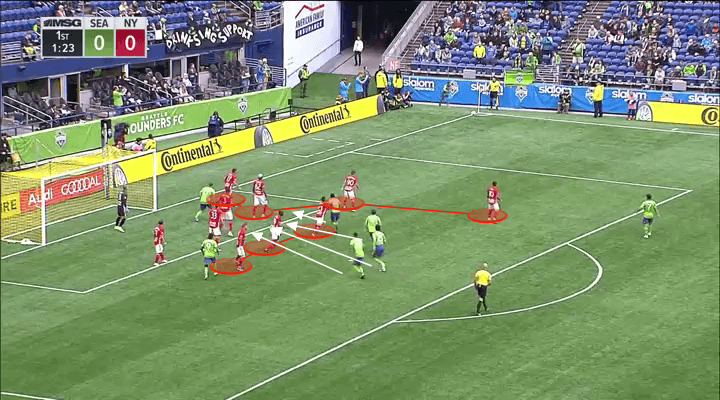
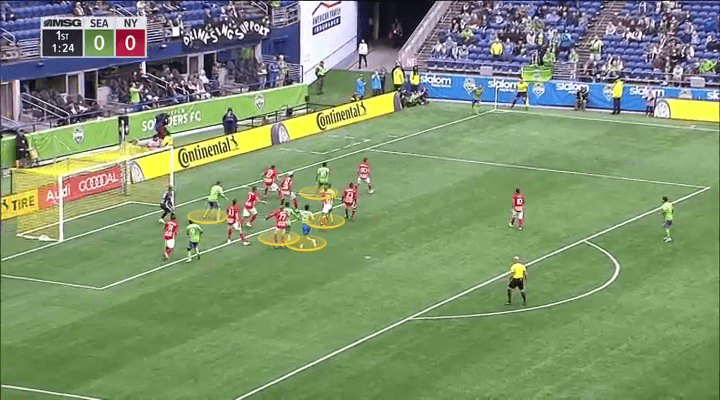
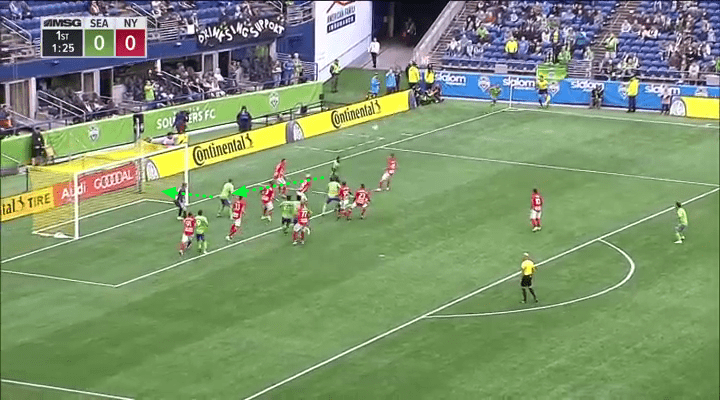
A similar scenario was almost repeated twice later in the half, Seattle’s near-post corner routine appeared to have the better of the Red Bulls within this game. Fortunately, the Seattle players headed over and failed to punish New York on both occasions.
The early goal set the tone for Seattle who could then adopt a patient build-up, a deeper defensive line and average formation for added security against the counter and when out of position. On the other hand, New York Red Bulls were forced to step up their formation in an attempt to squeeze the pitch and get their offensive players on the ball closer to the Sounders goal. Whether this was a pre-game tactical set up from New York is unknown, given the early nature of the first goal.
The stats back up these points, Seattle Sounders had the majority of possession overall and in each match segment. The hosts also offered a deeper defensive line when compared to New York Red Bulls. Interestingly, the PPDA stats suggest that both teams pressed with a similar intensity, with the two teams simply utilising different average pitch positions to execute such pressing intensity.
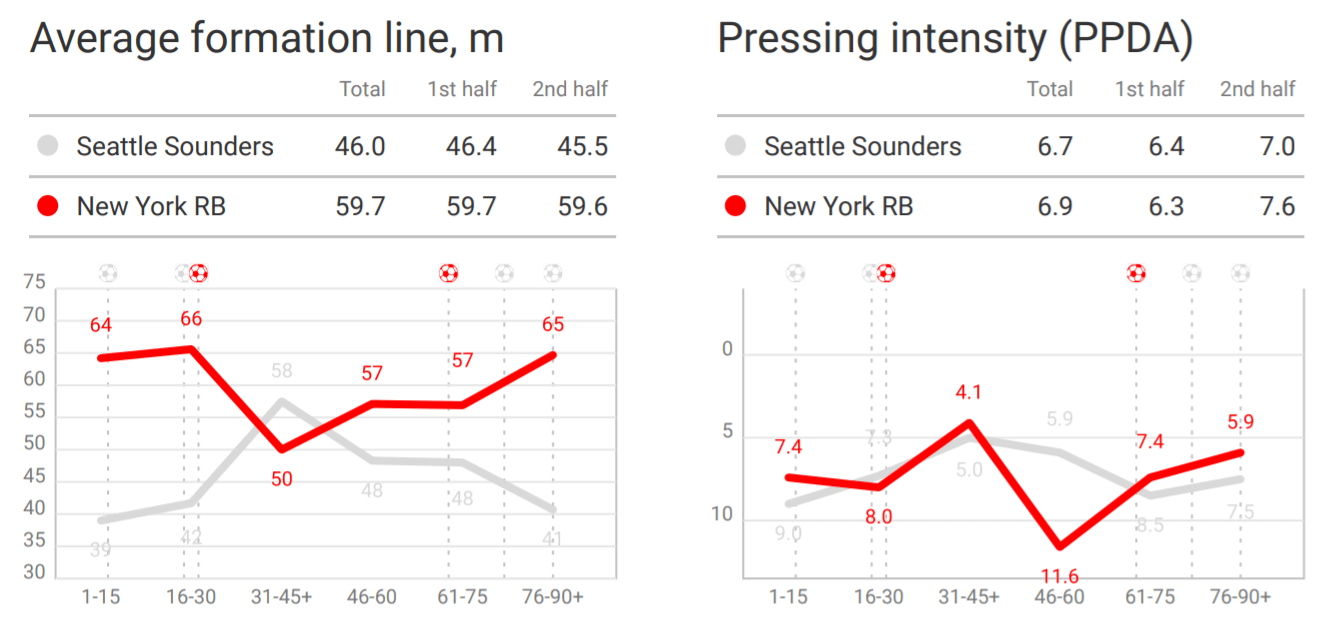
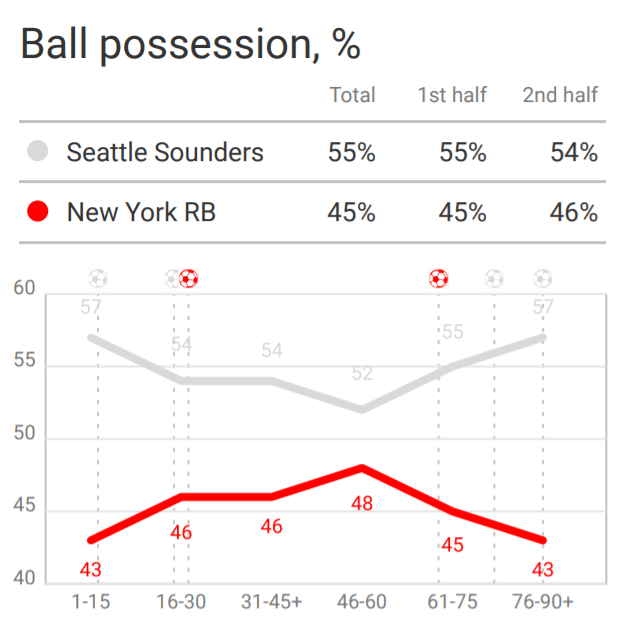
The Seattle Sounders extended their lead in the 23rd minute. Within this passage of play, it was the Sounders formation with more width than the Red Bulls tactical set up which contributed to the goal, along with a quick switch of play to exploit such width.
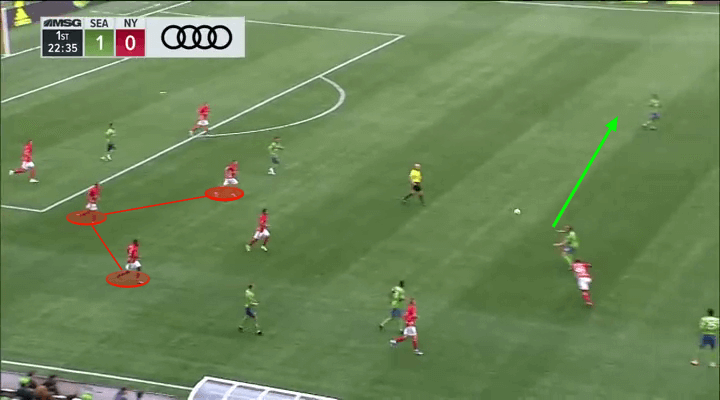
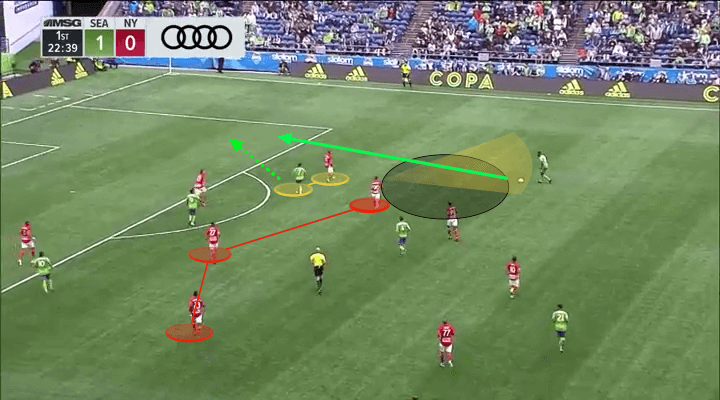
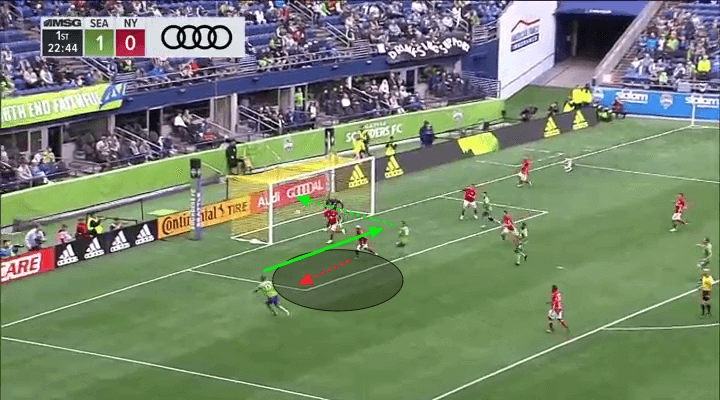
New York Red Bulls did manage to get themselves back in the game with their first real chance, a cross from the second phase of a free-kick on the right flank was headed home by their centre-back, Aaron Long, who had stayed up after the initial free-kick. New York will have hoped that Long attacked the goal-scoring corner from Seattle early in the game, the same way he attacked this cross to score.
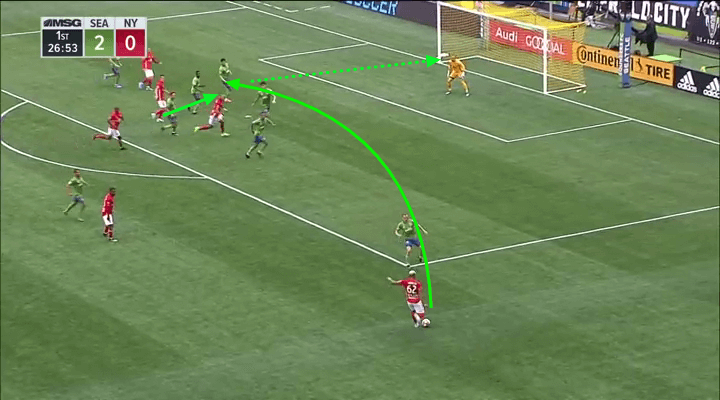
Second half
After entering half time 2-1 down, New York Red Bulls manager, Chris Armas, decided to switch to a 4-4-2 formation, offering more width and sacrificing a player in the number ’10’ position. A substitution just before half time forecasted such tactical tweaks, with central midfielder, Cristian Cásseres replaced by Josh Sims in the 38th minute. Sims moved out to right-midfield when the switch to 4-4-2 occurred as the second half started. The number ’10’, Alejandro Romero Gamarra was pushed alongside Bradley Wright-Phillips, with Daniel Royer moving over to left midfield.
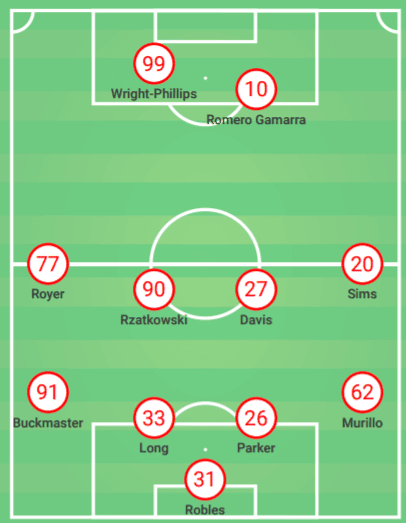
Understandably, Seattle Sounders started the second half unchanged either by positioning or personnel.
In the second half, Seattle defended with men behind the ball, forcing New York Red Bulls to break them down. When Seattle Sounders won the ball back, they attempted to counter-attack and play into space behind the high defensive line of the visitors. The more balanced 4-4-2 offered the Red Bulls more width and offered them more pitch coverage in both attack and defence. On a few occasions, the New York Red Bulls were able to utilise such width and combination play to create opportunities. Unfortunately, they were unable to take them and the Red Bulls appeared frustrated at times, although, they could perhaps count themselves fortunate that they were not punished on the counter within this period.
Eventually, in the 67th minute, the Red Bulls broke the Seattle resistance. A move inspired by the tactical switch to a 4-4-2 and the movement of offensive players paying dividends. A ball was played down the left-wing to Royer, Royer then cut the ball back to Romero Gamarra just inside the box and the then striker finished with a curling shot into the top right corner, 2-2.
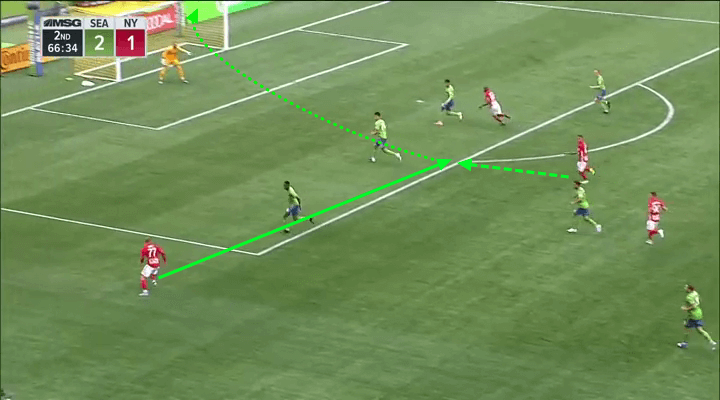
From that position, one would think that the Red Bulls would push on for a winner, with the momentum of the game with their team. Instead, there were few chances between the 67th minute and the winning goal for Seattle in the 83rd minute. The New York Red Bulls can count themselves somewhat unfortunate to concede the winning goal. Seattle played a decent passage of play and found Jordan Morris just inside the area. Morris could and should have been picked up by a retreating central midfield player who was caught ball watching as Seattle advanced down the left flank. However, as Morris received the ball, Micheal Murrillo and two other Red Bull defenders closed Morris down. This left space for Víctor Rodríguez to receive a pass. From there, he crossed the ball and in an attempt to clear, Sean Davis threw his leg at the ball, the ball deflected off of him and was diverted into the top corner of Luis Robles’ goal. A cruel way to lose the game, although, if all options were marked, Morris would not have had the opportunity to receive the ball and pass to Rodríguez. Nevertheless, the consequent deflection was tough on the Red Bulls.
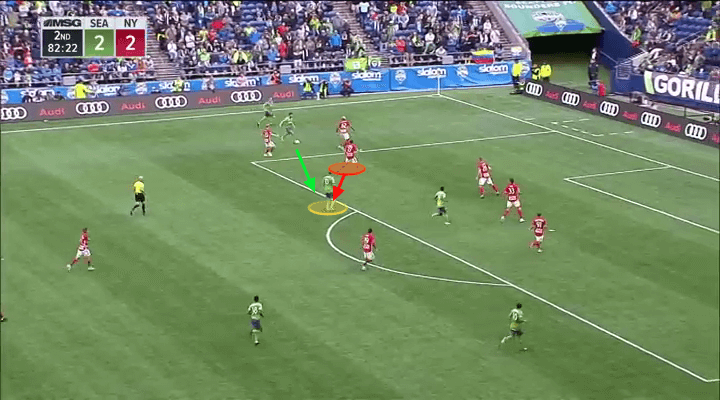
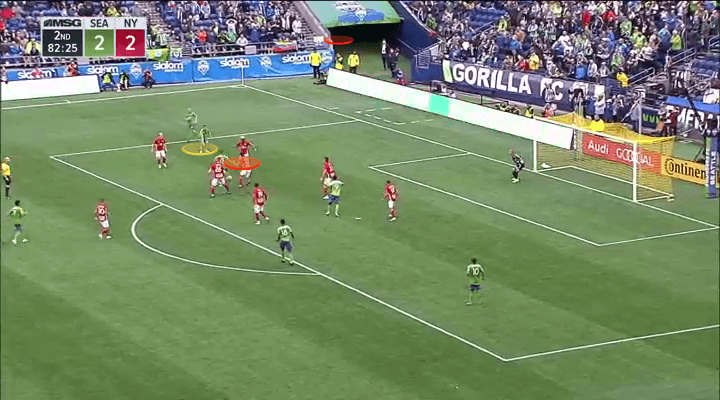
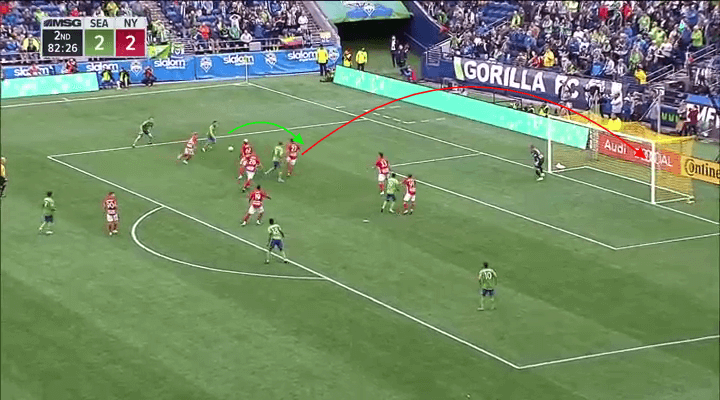
The New York Red Bulls attempted to get back into the game but did not create any chances of note between the own goal and the fourth goal for Seattle. Seattle adapted their tactics in order to protect their lead. They switched to a 5-4-1 and made a defensive substitution. Such changes helped them hold their opponents off.
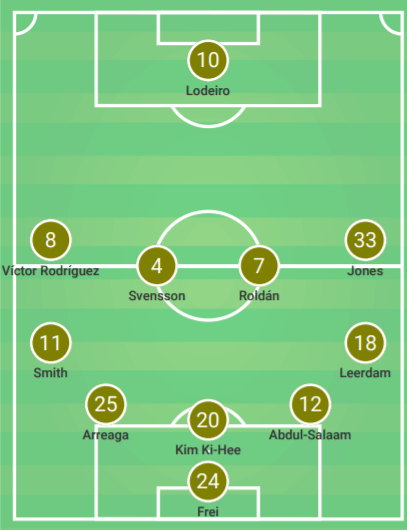
In the 94th minute, with New York Red Bulls throwing everything forward, Seattle broke away and sealed the win with a fourth goal.
Conclusion
Overall, the win for Brian Schmetzer’s Seattle Sounders was justified. They were much better than their MLS rivals, New York Red Bulls, in the first half, creating chances and punishing their opponents via near post corners and exploiting the lack of width in Chris Armas’ team. In the second half, a switch to a 4-4-2 with more balance and width led to an increased threat from the Red Bulls and enabled them to score the equaliser. From there, the visitors failed to push effectively for a winner, leading to Seattle taking the spoils after a somewhat fortuitous own goal, although the build-up play involved impressive movement and sub-standard marking from the visitors.

If you love tactical analysis, then you’ll love the digital magazines from totalfootballanalysis.com – a guaranteed 100+ pages of pure tactical analysis covering topics from the Premier League, Serie A, La Liga, Bundesliga and many, many more. Buy your copy of the August issue for just ₤4.99 here.






Comments